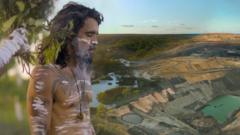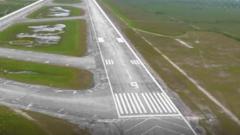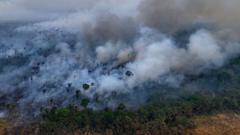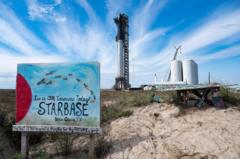As preparations for the COP30 climate summit in Belém, Brazil, ramp up, a new highway's construction through the Amazon rainforest has sparked outrage among locals and conservationists alike. The highway, while intended to improve access for summit attendees, threatens biodiversity, disrupts ecosystems, and displaces residents who rely on the forest for their livelihoods.
Controversy Arises as Road Construction Threatens Amazon for COP30
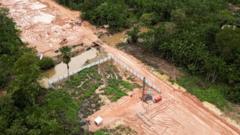
Controversy Arises as Road Construction Threatens Amazon for COP30
The construction of a new highway in Brazil's Amazon rainforest for the upcoming COP30 climate summit raises criticisms over its environmental impact and the displacement of local communities.
The construction of a four-lane highway in the Brazilian Amazon has ignited fierce debates surrounding the upcoming COP30 climate summit in Belém. While the aim is to facilitate increased traffic to accommodate over 50,000 attendees, including global leaders, environmentalists and local residents contend that this development contradicts the summit's foundational objectives pertaining to climate protection.
The highway, stretching over 13 kilometers through protected rainforest, has already resulted in significant deforestation, with large logs stacked on cleared land that was home to rich biodiversity. Critics argue that this destruction undermines efforts to limit climate change, as the Amazon plays a critical role in carbon absorption.
Local inhabitants, like Claudio Verequete, who previously harvested açaí berries from the now-cleared land, express despair over their lost income and the lack of compensation from authorities. “Everything was destroyed,” he laments. "We no longer have that income to support our family,” fearing further encroachments by businesses drawn to the newly accessible area.
Despite claims from the state government of Pará regarding the highway's “sustainable” aspects, like proposed wildlife crossings and bike lanes, the highway has drawn major concerns from conservationists. Experts warn of habitat fragmentation that could threaten wildlife movement and health, complicating rehabilitation efforts for injured animals.
Prof. Silvia Sardinha, a wildlife researcher, highlights that the fragmentation could limit the living and breeding spaces for various species. Meanwhile, the federal government envisions the summit as a chance to uplift the Amazon and address its needs, although locals feel unheard in the decision-making process.
Infrastructure projects related to the summit are being fast-tracked, including airport expansions and new parks, which supporters argue will lead to economic revitalization for the area. Business owners express hope that increased tourism could lead to more sales and improved local income.
Yet, the broader implications of such logistics for a climate summit infused with high-profile discussions are under scrutiny. Observers question whether the effort to bring thousands of officials and advocates into the Amazon undermines the cause; a concern mirrored by many environmentalists and affected residents alike as they strive for a balance between development and sustainability.
As the date for COP30 approaches, voices continue to emerge both for and against the ongoing construction and its ramifications for the Amazon, its people, and the planet's climate efforts.

